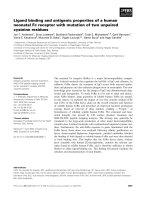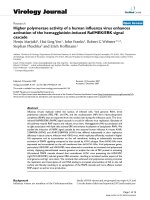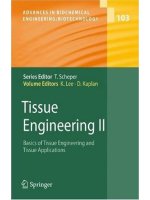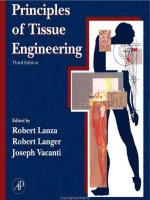Tissue engineering of a human periodontal ligament fibroblast membrane alveolar osteoblast scaffold double construct
Bạn đang xem bản rút gọn của tài liệu. Xem và tải ngay bản đầy đủ của tài liệu tại đây (8.44 MB, 220 trang )
TISSUE ENGINEERING OF A HUMAN PERIODONTAL
LIGAMENT FIBROBLAST MEMBRANE – ALVEOLAR
OSTEOBLAST SCAFFOLD DOUBLE CONSTRUCT
CHOU AI MEI
(B. Sc. (Hons), NUS)
A THESIS SUBMITTED
FOR THE DEGREE OF DOCTOR OF PHILOSOPHY
DEPARTMENT OF BIOLOGICAL SCIENCES
NATIONAL UNIVERSITY OF SINGAPORE
2007
i
ACKNOWLEDGEMENTS
I would like to express my most sincere gratitude to my supervisors: Prof. Hew Choy
Leong, A/P. Lim Tit Meng, A/P. Varawan Sae-Lim, and A/P. Dietmar Werner
Hutmacher for their supervision and support during this dissertation.
My deepest appreciation goes to A/P. Martha Somerman for her guidance in
establishing explant culture, and A/P. Michael Raghunath for his council in my
pursuit of collagen.
I would like to extend my gratitude to Prof. Teoh Swee Hin for his provision of
membrane fabrication facilities, and Dr Gregory Lunstrum for his generous gift of
anti-collagen XII and XIV antibodies.
My heartfelt thanks to Mr. Yan Tie, Soh Jim Kim Unice, Zhou Yefang and Li Zhimei,
as well as fellow members of the Tissue Engineering Laboratory, Developmental
Biology Laboratory, and the Centre for Biomedical Materials Applications and
Technology (BIOMAT), for their constructive suggestions and friendship.
I would also like to thank National University Hospital staff for their kind assistance
with tissue collection; Dr. Thorsten Schantz for his guidance on surgical procedures;
Ms. Patricia Netto and Ms. Tan Phay Shing Eunice for their technical instruction in
the use of Scanning Electron Microscopy and Atomic Force Microscopy, respectively.
ii
This work would not have been possible without the support from the Faculty
Research Grant (R-224-000-011-112) of the Faculty of Dentistry, as well as Graduate
Research Scholarships from the National University of Singapore, and the Agency for
Science, Technology and Research (A*STAR).
Last but not the least, I am grateful to God who called me to this journey of scientific-
and self-discovery, as well as to my family and loved ones for their encouragement
and patient understanding.
iii
TABLE OF CONTENTS
Acknowledgements i
Table of Contents iii
Summary x
List of Publications Related to This Thesis xi
List of Tables xiii
List of Figures xiv
List of Abbreviations xvii
iv
CHAPTER 1 INTRODUCTION
1.1. Introduction to periodontal regeneration 1
1.2. Limitations of current therapeutic procedures 2
1.3. Tissue engineering as a potential regenerative strategy 3
1.4. Research aim 4
CHAPTER 2 LITERATURE REVIEW
2.1. Anatomy of the periodontal ligament (PDL) 6
2.2. Connective tissue matrix of the PDL 7
2.2.1. Collagens 8
2.2.2. Noncollagenous proteins 12
2.2.3. Proteoglycans 13
2.3. Cells of the PDL 14
2.3.1. Development of the PDL 14
2.3.2. Cell populations and phenotype 17
2.4. Biology of periodontal regeneration 18
2.4.1. Molecules in periodontal regeneration 18
2.4.2. Cell populations in periodontal regeneration 19
2.5. Choice of scaffolds for periodontal tissue engineering 21
2.5.1. Scaffold morphology 21
2.5.2. Biodegradability 22
2.6. Surface properties of the biomaterial 23
2.6.1. Biocompatibility 23
2.6.2. Cell-substratum interactions 25
2.6.3. Surface wettability and protein adsorption 27
v
2.6.4. Surface topography, and cell growth and differentiation 30
2.7. Biodegradable synthetic polymers 32
2.7.1. Overview of polyesters 32
2.7.2. Poly(ε-caprolactone) (PCL) 34
CHAPTER 3 COMMON MATERIALS AND METHODS
3.1. Fabrication of PCL membranes 38
3.1.1. Solvent casting 38
3.1.2. Heat press and biaxial stretching 38
3.1.3. Perforation 39
3.1.4. Alkaline hydrolysis treatment 39
3.2. Collagen induction 40
3.3. Cell proliferation assay 40
3.4. Cell viability assay 41
3.5. Alkaline phosphatase (ALP) assays 41
3.5.1. ALP stain 41
3.5.2. ALP enzyme substrate assay 42
3.6. Collagen extraction by limited pepsin digestion 42
3.7. Sodium dodecyl sulphate-polyacrylamide gel electrophoresis (SDS-PAGE) 43
3.7.1. Tris-acetate gels 43
3.7.2. Tris-glycine gels 44
3.8. Protein gel stain 44
3.8.1. Coomassie Blue stain 44
3.8.2. PageBlue
TM
stain 44
3.8.3. Silver stain 45
vi
3.9. Western blot analysis 45
3.9.1. Protein transfer 45
3.9.2. Immunoblotting 46
3.10. Semi-quantitative densitometry 47
3.11. Double-labelling immunofluorescence 47
3.12. Phalloidin stain 48
3.13. Von Kossa stain 48
3.14. Confocal laser scanning microscopy 49
3.15. Scanning electron microscopy 49
3.16. Statistical analysis 50
CHAPTER 4 ESTABLISHMENT OF PRIMARY hPDLF CELL LINE IN
VITRO
4.1. Background 51
4.2. Materials and methods 52
4.2.1. Isolation of explants 52
4.2.2. Cell expansion and cryopreservation 54
4.2.3. Osteogenic induction 55
4.3. Results 55
4.3.1. Establishment of hPDLF and hAO cell lines 55
4.3.2. hPDLF cell line demonstrated ALP induction 56
4.3.3. hPDLF cell line demonstrated matrix maturation 58
4.3.4. hPDLF cell line demonstrated mineral-like tissue formation 59
4.5. Discussion 61
4.5.1. Characterization of hPDLF and hAO cell lines 61
vii
4.5.2. Analysis of ALP activity and mineralization potential 64
4.5.3. Patient-to-patient variation 66
CHAPTER 5 COLLAGEN SYNTHESIS DURING EXPANSION OF
PRIMARY hPDLF IN VITRO
5.1. Background 77
5.2. Materials and methods 79
5.2.1. Collagen induction 79
5.2.2. Reverse transcription polymerase chain reaction (RT-PCR) 80
5.2.3. Collagen I assay 81
5.2.4. SDS-PAGE 81
5.2.5. Immunofluorescence 82
5.3. Results 83
5.3.1. Asc supplementation led to increased collagen synthesis 83
5.3.2. Serum modulated collagen III and V, as well as fibre morphology 85
5.3.3. hPDLF produced the large isoforms of collagen XII and XIV 88
5.4. Discussion 89
5.4.1. Collagen synthesis and ALP activity 89
5.4.2. Collagen deposition and fibre morphology 90
5.4.3. hPDLF exhibited a dedifferentiated phenotype during expansion
in vitro that was partially reversed by serum deprivation 91
CHAPTER 6 DEVELOPMENT OF hPDLF-MEMBRANE CONSTRUCTS
6.1. Background 102
6.2. Material and methods 104
viii
6.2.1. Preparation of PCL membranes 104
6.2.2. Atomic force microscopy 104
6.2.3. Water contact angle measurements 104
6.2.4. Toluidine blue assay 105
6.2.5. Fibronectin adsorption 106
6.2.6. Seeding of hPDLF onto PCL membranes 106
6.2.7. Cell adhesion efficiency 107
6.2.8. Focal contact formation 108
6.3. Results 109
6.3.1. Alkali-treatment and perforation increased surface roughness and
area 109
6.3.2. Alkali-treatment increased wettability and accessibility of HFN7.1 110
6.3.3. Alkali-treatment increased cell adhesion and formation of focal
contacts 111
6.3.4. hPDLF-membrane constructs demonstrated FN and collagenous
matrix formation in the process of maturation 114
6.4. Discussion 117
6.4.1. Cytocompatibility of alkali-treated PCL membranes 117
6.4.2. Evaluation of hPDLF-membrane constructs 119
CHAPTER 7 TISSUE ENGINEERING OF A hPDLF MEMBRANE-hAO
SCAFFOLD DOUBLE CONSTRUCT
7.1. Background 133
7.2. Material and methods 134
7.2.1. Preparation of membranes and scaffolds 134
ix
7.2.2. Seeding and culture of hPDLF and hAO 135
7.2.3. Cell metabolic assay 136
7.2.4. Implantation 137
7.2.5. Histology 137
7.2.6. Immunohistochemical analysis 138
7.3. Results 138
7.3.1. Adhesion and proliferation of hPDLF and hAO in vitro 138
7.3.2. Tissue formation of hPDLF-hAO double construct in vivo 139
7.4. Discussion 141
7.4.1. Membranes and scaffolds supported cell adhesion and proliferation
in vitro 141
7.4.2. Membrane-scaffold double construct facilitated tissue growth and
vascularization in vivo 143
CHAPTER 8 GENERAL CONCLUSIONS AND FUTURE WORK
8.1. General conclusions 153
8.2. Future work 154
REFERENCE 156
APPENDIX 188
x
SUMMARY
This study aimed to develop a human periodontal ligament fibroblast
(hPDLF)-alveolar osteoblast (hAO) cell-scaffold double construct. Ten hPDLF and
three hAO primary cell lines were established by explant culture up to passage 3-5.
hPDLF and hAO produced varying levels of alkaline phosphatase and mineral-like
tissue upon osteogenic induction by day 28. Three selected hPDLF cell lines
demonstrated a preservation of collagen-synthetic capability as seen from the
synthesis of type I, III, V, XII and XIV, and a dedifferentiated or embryonic-like
collagenous matrix under culture expansion in the presence of ascorbic acid over 21
days. Cell-substratum interactions of three hPDLF cell lines on poly(ε-caprolactone)
(PCL) membranes were examined. Cytocompatibility of alkali-treated PCL
membranes was enhanced via a two-fold increase in cell adhesion rate and total
efficiency, attributable to a greater accessibility of fibronectin cell-binding domain.
Constructs consisting of perforated PCL membranes provided greater cell anchorage,
and cell and matrix alignment than unperforated ones via contact guidance, while
retaining hPDLF phenotypic expression and promoting matrix maturation at day 21.
hPDLF proliferated on alkali-treated, perforated PCL membranes, while hAO
produced mineral-like tissue on alkali-treated PCL scaffolds at day 21. Vascularized,
well-integrated hPDLF-hAO double construct was observed at day 28 of
subcutaneous implantation in athymic mice, but no further osteogenesis in the earlier-
mineralized matrix was seen.
xi
LIST OF PUBLICATIONS RELATED TO THIS THESIS
This thesis is submitted for the degree of Doctorate of Philosophy in the
Department of Biological Sciences at the National University of Singapore. No part of
this thesis has been submitted for any other degree or equivalent to another university
or institution. All the work in this thesis is original unless references are made to other
works. Parts of this thesis have been published or presented in the following:
International Journal Publications
Chou A.M.
, Sae-Lim V., Hutmacher D.W., Lim T.M. Tissue Engineering of a
Periodontal Ligament-Alveolar Bone Graft Construct. The International Journal of
Oral & Maxillofacial Implants, 21: 526–534, 2006.
Chou A.M.
, Sae-Lim V., Lim T. M., Schantz J.T., Teoh S.H., Chew C.L., Hutmacher
D.W. Culturing and Characterization of Human Periodontal Ligament Fibroblasts – A
Preliminary Study, Materials Science and Engineering C, 20: 77–83, 2002.
Presentations and Awards
Chou A.M.
, Sae-Lim V., Hutmacher D.W., Lim T.M. Effects of Ascorbic Acid 2-
Phosphate on Human Periodontal Ligament Fibroblasts under Low and High Serum
Conditions in vitro. 8
th
Annual Meeting of Tissue Engineering Society International,
China (2005); Merit winner award (Dental poster), Combined Scientific Meeting,
Singapore (2005)
Chou A.M.
, Sae-Lim V., Hutmacher D.W., Lim T.M. Characterization of Human
Periodontal Ligament Cell Sheets on Ultra-Thin and Cell-Permeable Bioresorbable
xii
Membrane. 6
th
Annual Meeting of Tissue Engineering Society International, USA
(2003); 7
th
NUS-NUH Annual Scientific Meeting, Singapore (2003)
Chou A.M.
, Sae-Lim V., Zhou Y.F., Hutmacher D.W., Lim T.M. Preliminary studies
on human periodontal ligament fibroblasts and alveolar osteoblasts cultured on foil-
scaffold constructs. Young Investigator Award, 1
st
NHG Scientific Congress,
Singapore (2002); Best Clinical Science Poster Award, 6
th
NUS-NUH Annual
Scientific Meeting (2002)
xiii
LIST OF TABLES
2.1 Summary of reported collagens in the PDL (Adapted from Kirkham and
Robinson, 1995; Kielty and Grant, 2002).
11
2.2 Summary of selected polyesters (Gunatillake and Adhikari, 2003).
34
4.1 Summary of western blot results (Fig. 4.5) of ON, OPN and BSP
synthesis by paired hPDLF and hAO, derived from three individuals,
under normal and mineralizing culture.
73
4.2 Biodata of donors, categorized by the pattern of mineral-like nodule
formation at day 28 in hPDLF and hAO.
75
5.1 List of primer sequences and expected size of PCR products.
94
7.1 Summary of immunostaining results.
151
xiv
LIST OF FIGURES
1.1 Schematic representation of periodontal regeneration using an
autologous cell-scaffold construct.
5
2.1 Stages in collagen synthesis (adapted from Gage et al., 1989).
10
2.2 Schematic representation of a developing tooth bud at the cap stage
(adapted from Cho and Garant, 2000).
16
2.3 The contact angle of a liquid with a solid.
28
2.4 Illustration of events at the biomaterial surface (adapted from Kasemo
and Gold, 1999).
29
4.1 Representative images of cellular outgrowth and morphology of hPDLF
and hAO.
68
4.2 Effects of dexamethasone (Dex) on the alkaline phosphatase (ALP)
activities of hPDLF and hAO.
69
4.3 ALP activities of hPDLF and hAO cultured in the absence and presence
of 100 nM Dex.
70
4.4 Representative images of (A-B) hPDLF and (C-D) hAO after staining
for ALP under normal and mineralizing cultures, respectively.
71
4.5 Western blot analysis of (A) osteonectin (ON), (B) osteopontin (OPN)
and (C) bone sialoprotein (BSP) in whole cell lysates of paired hPDLF
and hAO, derived from three individuals, under normal and
mineralizing culture.
72
4.6 Representative morphology of hPDLF (A-C) and hAO (D-F) at stage I,
II and III of nodule formation, respectively.
74
4.7 Mineral-like tissue formation in hPDLF and hAO under mineralizing
culture, as observed (A-C) before and (D-F) after von Kossa staining at
day 28.
74
4.8
Correlation between ALP activity and mineral-like nodule formation in
hPDLF and hAO.
76
4.9 Schematic diagram showing the metabolism of ATP and AMP, and the
role of ALP on mineralization.
76
5.1 Synthesis of (A) DNA and (B) proteins over time.
94
5.2 Gene expression of three representative collagens in the PDL, namely
types I, III and XII, as represented by their respective α1 chains using
RT-PCR.
95
xv
5.3 Synthesis of (A) collagen I and (B) alkaline phosphatase (ALP),
normalized to dsDNA. 95
5.4 Three-day window of collagen synthesis.
96
5.5 Accumulative collagen deposition. 96
5.6 Silver-stained non-reducing SDS-PAGE of cell layer fractions in 3-8%
Tris-acetate gel, as compared to that in 5% Tris-glycine gels.
97
5.7 Ratio of collagenous peptides obtained by limited pepsin digestion of
medium and cell layer fractions under 0.2% and 10% FBS over time, as
determined by densitometry.
98
5.8 Phase contrast light (PCLM) and fluorescence light microscopy images
of hPDLF cultures stained with anti-collagen I-FITC antibody at day 21
(200x magnification).
99
5.9 Confocal laser microscopy images of hPDLF cultures double immuno-
labeled for collagen I/XII and I/XIV, and singly labeled for collagen III
at day 21. Cells were counter-stained with Hoechst (scale bar = 50 μm).
100
5.10 Western blot analysis of undigested medium.
101
6.1 Modulation of cell behaviour through substrate-dependent changes in
FN conformation (adapted from Garcia et al., 1999).
121
6.2 Manufacturing procedure and classification of PCL membranes.
121
6.3 Representative surface morphologies of UP/UT, UP/T, P/UT, P/T
membranes obtained by scanning electron (SEM) and atomic force
(AFM) microscopy.
122
6.4 (A) Root-mean-square (RMS) surface roughness and (B) surface area of
membranes obtained by AFM at a scan size of 5 μm x 5 μm.
123
6.5 Optical density of ELISA of antibody binding to FN adsorbed from 2
μg/ml by (A) anti-FN polyclonal antibody and (B) HFN7.1 monoclonal
antibody in the absence and presence of a 100-fold excess of BSA.
123
6.6
Representative PCLM images of hPDLF attached onto UP/UT, UP/T,
P/UT, and P/T membranes at 1, 2, 6 and 18 h after seeding in culture
medium containing 10% serum (magnification 600X).
124
6.7
Adhesion efficiency of hPDLF, expressed as the percentage of double-
stranded DNA (dsDNA) harvested from attached cells from initial cell
suspension, at 1, 2, 6 and 18 h after seeding on membranes.
125
6.8 Immunofluorescence of f-actin (green) and vinculin (red) in hPDLF at 6,
12 and 24 h after seeding on membranes (scale bar = 50 μm).
127
xvi
6.9 Close-up images of Fig. 6.8 (numbered boxes) of vinculin (red) at 24 h
after seeding on membranes (scale bar = 10 μm).
127
6.10 Representative images of hPDLF cell sheet on UP/T and P/T
membranes (magnification 100X, unless stated otherwise).
128
6.11 Cell sheet coverage on membranes as deduced from FDA/PI staining at
100X magnification after image analysis by Micro-Image® over 21
days.
129
6.12 Cell proliferation in terms of dsDNA harvested from attached hPDLF
over 21 days.
129
6.13 Western blot and densitometric analysis of reducing SDS-PAGE
containing whole cell lysates of hPDLF cultured on UP/T, P/T
membranes and TCP at day 21.
130
6.14 Representative images of non-reducing SDS-PAGE in 3-8% gradient
Tris-acetate gel of (A) medium and (B) cell layer fractions after limited
pepsin digestion at day 21.
130
6.15 Representative confocal laser microscopy images of hPDLF
immunolabeled for FN and type I collagen on UP/T membrane, P/T
membrane and TCP at day 21 (scale bar = 50 μm).
131
6.16 Level of alkaline phosphatase (ALP) of hPDLF at day 7, 14 and 21.
132
7.1 Attachment, growth and viability of hPDLF on PCL membranes.
146
7.2 Attachment, morphology and viability of hAO on PCL scaffolds.
147
7.3 Metabolic activities of hPDLF on membranes and of hAO on scaffolds,
with their respective wells at weekly intervals.
148
7.4 Implantation and excision of membrane-scaffold constructs.
149
7.5 Histological analysis of constructs after 4-weeks in vivo.
150
7.6 Immunohistochemical analysis of constructs after 4-weeks in vivo.
152
xvii
LIST OF ABBREVIATIONS
5’NT 5’ nucleotidase
AFM atomic force microscopy
AMP adenosine monophosphate
AO alveolar osteoblast
Arg arginine
Asc ascorbic acid
Asp aspartate
ATP adenosine 5'-triphosphate
β-GP beta-glycerophosphate
BMP bone morphogenetic protein
BSA bovine serum albumin
BSP bone sialoprotein
cDNA complementary DNA
DAB 3,3'-diaminobenzidine
Dex dexamethasone
DMEM Dulbecco’s Modified Eagle Medium
DMSO dimethyl sulphoxide
DNA deoxyribonucleic acid
DTT dithiothreitol
ECL enhanced chemiluminescence
ECM extracellular matrix
EDTA ethylenediaminotetraacetic acid
ELISA enzyme-linked immunosorbent assay
xviii
EtBR ethidium bromide
FBS fetal bovine serum
FDA fluorescein diacetate
FDM fused deposition modeling
FITC fluorescein isothiocyanate
FN fibronectin
FRET fluorescence resonance energy transfer
g gram
Gly glycine
h human
HRP horseradish peroxidase
Kb kilo base
kDa kilo Dalton
LDS lithium dodecyl sulfate
M molar
MAPK mitogen-activated protein kinase
min minute
MTS 3-(4,5-dimethylthiazol-2-yl)-5-(3-carboxy-
methoxyphenyl)-2-(4-sulfophenyl)-2H-tetrazolium
NADP nicotinamide adenine dinucleotide phosphate
NaOH sodium hydroxide
NTPPPH nucleoside triphosphate pyrophosphohydrolase
OD optical density
ON osteonectin
OPN osteopontin
xix
PBS phosphate buffered saline
PCL poly(ε-caprolactone)
PCLM phase contrast light microscopy
PCR polymerase chain reaction
PDL periodontal ligament
PDLF periodontal ligament fibroblast
PHSRN Pro-His-Ser-Arg-Asn
Pi inorganic phosphate
PI propidium iodide
PPi inorganic pyrophosphate
RGD Arg-Gly-Asp
RNA ribonucleic acid
SD standard deviation
SDS sodium dedocyl sulphate
SEM scanning electron microscopy
sec second
Tris trishydroxyaminomethane
TRITC tetramethylrhodamine isothiocyanate
IU international unit
UV ultra-violet
VN vitronectin
v/v volume by volume
w/v weight by volume
Introduction
1. INTRODUCTION
1.1. Introduction to periodontal regeneration
Periodontal regeneration aims to achieve reconstitution of soft (gingival and
periodontal ligament) and mineralized (bone and cementum) tissues lost due to
periodontal disease or trauma, as well as congenital defects. Ideally, four criteria must
be met in order for regeneration to have occurred. These include the restoration of (i)
a functional epithelial seal, (ii) new connective tissue fibres (Sharpey’s fibres) on the
root surface to reproduce both the periodontal ligament (PDL) and the dentogingival
fibre complex, (iii) new acellular, extrinsic fibre cementum on the root surface, and
(iv) alveolar bone height (Bartold et al., 2000). In essence, all the features of the
normal dentogingival complex have to be restored to their original form, function and
consistency.
Regeneration of the alveolar bone and other periodontal structures does not
usually occur on a clinically predictable basis (Melcher, 1976). Instead, healing takes
place, consisting of inflammation, granulation tissue formation and tissue remodelling
(Clark, 1996). Periodontal healing following mechanical or surgical therapy leads to
one of the following outcomes: a control of inflammation, formation of long
junctional epithelium, connective tissue re-attachment to the root surface, new bone
formation, root resorption and/or ankylosis, or formation of new functional
attachment apparatus (reviewed in Bartold and Narayanan, 1998).
The outcome of healing by regeneration or repair by scar tissue depends upon
at least three factors that are not mutually exclusive: (i) availability of the appropriate
cell type(s), (ii) soluble mediators of cell function that activate these cells, and (iii) a
developing extracellular matrix (ECM) (Bartold et al., 2000).
1
Introduction
1.2. Limitations of current therapeutic procedures
Conventional periodontal surgical procedures, such as surgical debridement
and resective procedures, have been established as effective treatment regimes (Hill et
al., 1981; Lindhe et al., 1982; Pihlstrom et al., 1983; Ramfjord et al., 1987; Becker et
al., 1988; Kaldahl et al., 1996). This may be accomplished by the excision of tissues,
or by the attempted replacement and attachment of tissues to the root surface. Despite
this, healing typically takes place by repair. The failure to obtain a new connective
tissue attachment after conventional periodontal therapy has been attributed to the
formation of long junctional epithelium, as a result of an ability of oral epithelium to
migrate apically along the root surface (Caton and Nyman, 1980; Caton et al., 1980).
Hence, the formation of new epithelial attachment is classified as repair and not
regeneration.
A regenerative therapeutic approach called “guided tissue regeneration” (GTR)
was thus developed based on the exclusion of gingival connective tissue cells from
the wound and the prevention of apical migration of epithelium, thus favouring
healing primarily from the PDL space and adjacent alveolar bone (reviewed in
American Academy of Periodontology, 2005). This procedure consists of the
placement of a barrier membrane between the periodontal defect and the gingival
tissues (GTR), or between the bone defect and the gingival tissues (guided bone
regeneration, GBR). First introduced by Nyman et al. (1982), these barriers allow
controlled repopulation by cells with regenerative potential, such as PDL cells, bone
cells and possibly cementoblasts, space maintenance and clot stabilization at the
wound site (Nyman et al., 1982; Caton et al., 1987; Nyman et al., 1987). The use of
bone allografts consisting of tricalcium phosphate and/or decalcified freeze-dried
2
Introduction
bone in addition to barrier membrane further augmented bone fill (Schallhorn and
McClain, 1988; Anderegg et al., 1991).
Despite the fact that guided tissue regeneration (GTR) and osseous grafting
are the two techniques with the most histological documentation of periodontal
regeneration (reviewed in Academy Report, 2005), clinical outcome was still less than
optimal for a number of reasons (Bartold et al., 2000), including: (i) preferential
regeneration of bone over that of cementum and fibrous connective tissues, (ii)
inability to control the formation of a long junctional epithelium, and (iii) inability to
adequately seal the healing site from the oral environment and prevent infection.
Therefore, current difficulties associated with achieving predictable
periodontal regeneration point to the need for novel techniques in order to regenerate
the critically lost or damaged soft and hard tissues. As mentioned previously, the
outcome of healing depends upon an availability of appropriate cell type(s), biological
mediators, and a developing ECM (Bartold et al., 2000). This could be realized by
developing tissue engineering strategies, as detailed in the next section.
1.3. Tissue engineering as a potential regenerative strategy
Tissue engineering is the application of principles and methods of engineering
and life sciences toward fundamental understanding of structure-function
relationships in normal and pathological mammalian tissues, and the development of
biological substitutes to restore, maintain, or improve tissue function (Langer and
Vacanti, 1993). It involves the use of a combination of cells, scaffolds and suitable
biochemical factors, as opposed to inert implants, in developing biological substitutes.
Tissue engineering efforts in dentistry are aimed at replacing the supporting structures
3
Introduction
of the dentition as well as the surrounding soft tissue for restoration of function
(Buckley et al., 1999).
The application of cell-based scaffold constructs is postulated to be a potential
regenerative strategy in reconstituting normal periodontal tissue architecture (Bartold
et al., 2000). Due to the juxtaposition of the PDL between the alveolar bone and the
root, it is hypothesized that optimal and sustained availability of viable PDL cells on
the damaged denuded root surface would facilitate periodontal tissue regeneration
(Hasegawa et al., 2005). Cell sheets of selective phenotype (Okuda et al., 2004)
theoretically provide the critical cell mass allowing for competitive wound healing
favouring desirable tissue regeneration (Gottlow et al., 1984, Sae-Lim et al., 2004). In
this way, the need for recruitment of cells to the site is negated and the predictability
of the outcome may be enhanced. Moreover, the periodontium is under constant
mechanical loading. A cell-supportive scaffold would hypothetically maintain the
integrity of the engineered tissue during and after implantation.
The most likely source of cells for periodontal tissue engineering is the PDL
and alveolar bone, whose progenitor cells could be isolated and propagated in culture
for seeding into scaffolds. Preliminary studies have indicated that cells from the PDL
(Van Dijk et al., 1991; Lang et al., 1998) and bone (Malekzadeh et al., 1998) can be
transplanted into periodontal sites with no adverse immunologic or inflammatory
consequences, giving rise to new connective tissue attachment and bone.
1.4. Research aim
It is envisioned that tissue-engineered cell-scaffold constructs could be
obtained by a stimulation of autologous periodontal cells into the desired cell lineages
within scaffolds of biocompatible material, and that the subsequent implantation of
4
Introduction
such a construct could lead to autologous cell-based therapy (Fig. 1.1). The aim of
this thesis was therefore to tissue engineer a hPDLF membrane-hAO scaffold double
construct for the purpose of periodontal regeneration.
Cementum
Enamel
Alveolar bone loss
Gingiva
recession
Diseased
Cell
Cell
-
-
scaffold
scaffold
constructs
constructs
Cementum
Enamel
Alveolar bone
Gingiva
Restored
Cementum
Enamel
Alveolar bone loss
Gingiva
recession
Diseased
Cementum
Enamel
Alveolar bone loss
Gingiva
recession
Cementum
Enamel
Alveolar bone loss
Gingiva
recession
Diseased
Cell
Cell
-
-
scaffold
scaffold
constructs
constructs
Cementum
Enamel
Alveolar bone
Gingiva
Restored
Cell
Cell
-
-
scaffold
scaffold
constructs
constructs
Cementum
Enamel
Alveolar bone
Gingiva
Cell
Cell
-
-
scaffold
scaffold
constructs
constructs
Cementum
Enamel
Alveolar bone
Gingiva
Restored
Figure 1.1. Schematic representation of periodontal regeneration using an
autologous cell-scaffold construct.
5









